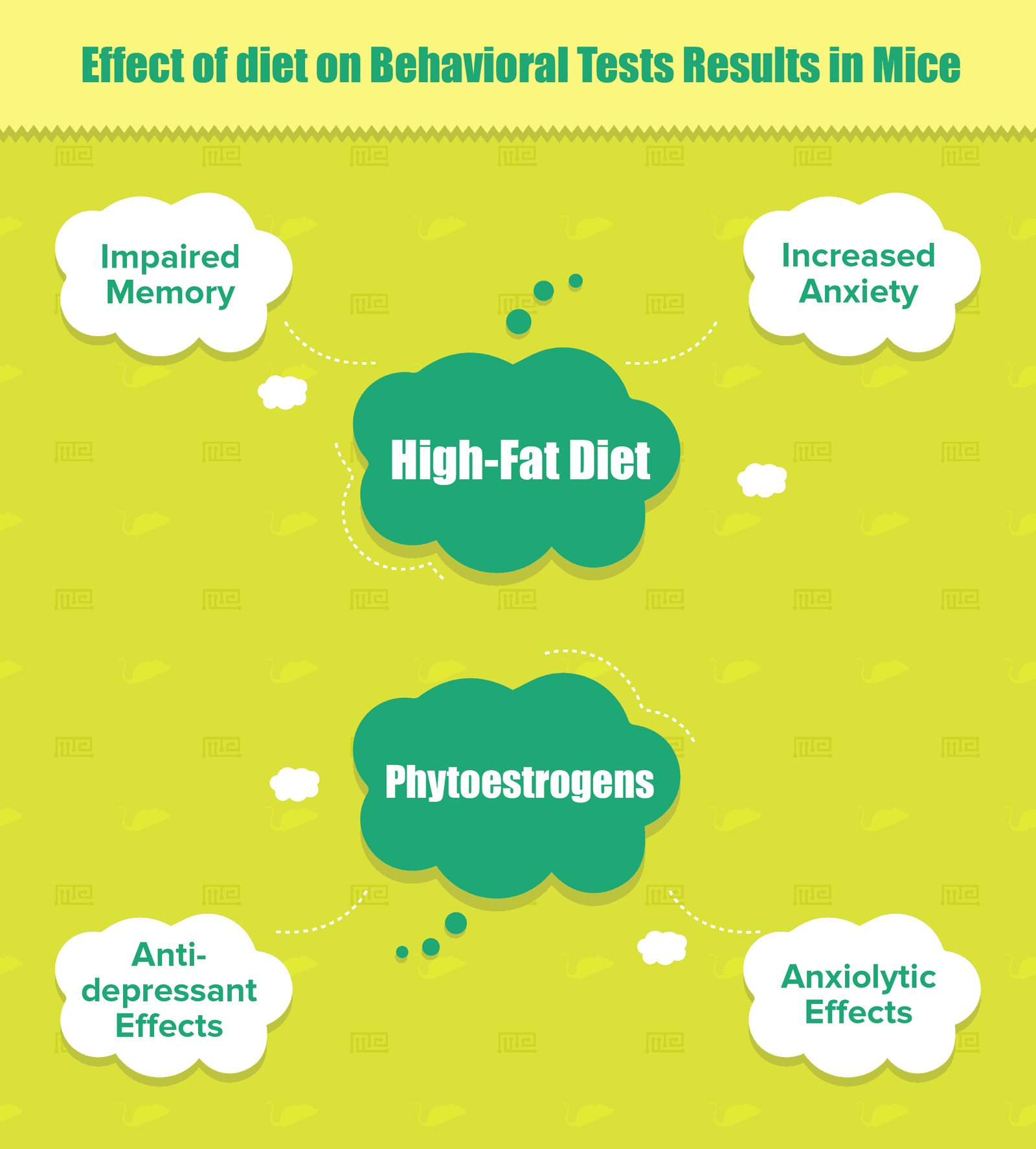From stressing the importance of breakfast before class to encouraging the right intake of vitamins, we’ve all heard about how our diet can affect our mood, physical energy, and brain function. But have you ever stopped to consider whether a diet can also affect your laboratory animals, and therefore your behavioral testing results?
Many studies have addressed the ability of various dietary components to directly modify rodent behavior. These studies include modifications in the fat content of the diet, changes in individual fatty acids, and various dietary restriction or overfeeding regimens. All of these components of feeding can affect mood-related behavior, cognition, and motor function.
While it is readily apparent how a high-fat diet that induces obesity in an animal could cause a change in physical mobility, it’s not so obvious how this same diet might affect an animal’s level of anxiety or how well they can navigate a maze. But researchers have found that high-fat diets in rodents can have profound effects on cognitive function and anxiety-like behavior, even in the short term, before the animals become obese.
Mice on a short-term high-fat diet develop impaired memory in a novel object recognition test, as well as increased anxiety in the open field test and elevated zero maze[1]. Longer-term high-fat diets cause similar effects, such as increased anxiety in the elevated plus maze and impaired spatial memory in the Y maze[2]. The diets may cause these changes by altering the levels of inflammation in the brain[2], or perhaps by altering the gut microbiota[3].
Phytoestrogens are a common component of laboratory rodent chow that can also influence behavior[6]. In mice, phytoestrogen supplementation has anti-depressant effects in the forced-swim test[4]. A phytoestrogen-rich diet was also found to be anxiolytic in the elevated plus maze and to alter performance in the radial arm maze test of visual-spatial memory[5]. While many standard lab chows contain phytoestrogens, some types of chow are made without these components due to their potential hormonal effects. These examples are just a few of the many ways that dietary components can affect rodent behavior. What does this all mean for your studies?
Most laboratory rodents are fed standard chow. Chow diets typically include a combination of oats, corn, soy, and/or other grains that are supplemented with vitamins and minerals, although the exact composition is usually not revealed and may differ across brands. Different labs may use different brands of chow.
As with all aspects of behavioral testing, the key is to maintain consistency between experiments and to avoid any dietary changes mid-experiment. There have been instances within individual labs where experimental results could not be duplicated, and it turned out that differences in the rodent chow were responsible for the inconsistencies.
It is also important that if you are testing the effects of an experimental diet, such as a high-fat diet, that you use a proper control diet and not simply standard rodent chow as your control[7]. Defined diets such as the high-fat diet can contain very different components than standard chow, including sucrose as a carbohydrate, protein from casein (milk protein), and added cellulose fiber as opposed to intrinsic grain fiber. Defined diets are also free of soy and therefore lack phytoestrogens.
Along these same lines, what happens to behavior when an animal is deprived of food? Fasting increases the sensitivity of mice to olfactory cues and increases their motivation for a food reward[8]. Thus, if food is being used as a reward in your testing paradigm, such as in the Y maze or radial arm maze, food restriction prior to the test may be a critical part of the protocol. The animals should be hungry enough that they are motivated to perform the desired behavior for the food reward.
If fasting is part of your protocol, it is also important to consider the time of day: rodents are much more active and typically consume more food at night, so if you are testing during the night, fasting will probably have a greater effect on your results than if you are testing during the day.
As the saying goes, we are what we eat. Rodents are no exception, and the evidence shows that diet is a key modulator of their behavior.
References
- Gainey SJ, Kwakwa KA, Bray JK, Pillote MM, Tir VL, Towers AE, Freund GG. Short-Term High-Fat Diet (HFD) Induced Anxiety-Like Behaviors and Cognitive Impairment Are Improved with Treatment by Glyburide. Front Behav Neurosci. 2016 10:156.
- André C, Dinel AL, Ferreira G, Layé S, Castanon N. Diet-induced obesity progressively alters cognition, anxiety-like behavior and lipopolysaccharide-induced depressive-like behavior: focus on brain indoleamine 2,3-dioxygenase activation. Brain Behav Immun. 2014 41:10-21.
- Jørgensen BP, Hansen JT, Krych L, Larsen C, Klein AB, Nielsen DS, Josefsen K, Hansen AK, Sørensen DB. A Possible Link between Food and Mood: Dietary Impact on Gut Microbiota and Behavior in BALB/c Mice. PLoS One. 2014; 9(8): e103398.
- Blake C, Fabick KM, Setchell KD, Lund TD, Lephart ED. Neuromodulation by soy diets or equol: anti-depressive & anti-obesity-like influences, age- & hormone-dependent effects. BMC Neurosci. 2011 Mar 16;12:28.
- Lephart ED, West TW, Weber KS, Rhees RW, Setchell KD, Adlercreutz H, Lund TD. Neurobehavioral effects of dietary soy phytoestrogens. Neurotoxicol Teratol. 2002 24(1):5-16.
- Lephart ED, Setchell KD, Handa RJ, Lund TD. Behavioral effects of endocrine-disrupting substances: phytoestrogens. Ilar J. 2004;45:443–454.
- Warden CH and Fisler JS. Comparisons of diets used in animal models of high fat feeding. Cell Metab. 2008 7(4): 277.
- Yang M, Crawley JN. Simple Behavioral Assessment of Mouse Olfaction. Curr Protoc Neurosci. 2009 Jul; CHAPTER: Unit–8.24.

